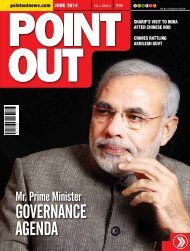You also want an ePaper? Increase the reach of your titles
YUMPU automatically turns print PDFs into web optimized ePapers that Google loves.
Point<br />
Out<br />
State of Economy<br />
Financial Inclusion-<br />
A Collective Responsibility<br />
»»<br />
S. L. Bansal<br />
As a professional banker, I would<br />
always like to foresee inclusive<br />
growth for our 1.2 billion<br />
population. However, after over<br />
four decades of nationalization of banks,<br />
the challenges of financial inclusion<br />
still remain as only 36,000+ habitations<br />
have a commercial bank branch out of<br />
the 6,00,000 habitations in the country.<br />
With the help of technology banks have<br />
expanded their network by opening of<br />
more & more branches over the last few<br />
years. Inspite of this, only 40% of the<br />
population across the country have bank<br />
accounts and only 10% have access to<br />
credit products.<br />
We can divide 1.2 billion population<br />
of the country into three segments. The<br />
first segment includes those who are not<br />
dealing with the banks and are financially<br />
excluded. The remaining population is of<br />
two segments - high networth individuals<br />
(HNIs) and small and medium income<br />
groups. This latter group is growing fast.<br />
Every year close to 3 crore people from<br />
the young generation are being added to<br />
the banking system and these people who<br />
will be the core customers in the future,<br />
have non-conventional banking habits<br />
and are very close to Western culture.<br />
They don’t live by their pay package and<br />
obligations - they live by their EMIs. As a<br />
Every year close to 3 crore people from the<br />
young generation are being added to the<br />
banking system and these people who will<br />
be the core customers in the future, have<br />
non-conventional banking habits and are<br />
very close to Western culture. They don’t<br />
live by their pay package and obligations -<br />
they live by their EMIs.<br />
result, our savings ratio is coming down<br />
gradually. So, if the consumption pattern<br />
is undergoing a change and people are<br />
believing more and more in spending,<br />
then for a developing country such as<br />
India with such a big population, it’s a<br />
huge challenge because we cannot get<br />
the kind of resources into the banking<br />
industry for meeting the growing credit<br />
needs of such an economy. Therefore,<br />
banks have to develop new customized<br />
products which will be attractive to these<br />
young customers.<br />
48<br />
<strong>MARCH</strong> 2014













